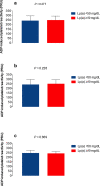Relation of High Lipoprotein (a) Concentrations to Platelet Reactivity in Individuals with and Without Coronary Artery Disease
- PMID: 32889667
- PMCID: PMC7547998
- DOI: 10.1007/s12325-020-01483-y
Relation of High Lipoprotein (a) Concentrations to Platelet Reactivity in Individuals with and Without Coronary Artery Disease
Abstract
Introduction: Lipoprotein (a) [Lp(a)] is a risk factor for coronary artery disease (CAD). To the best of our knowledge, this is the first study addressing the relationship between Lp(a) and platelet reactivity in primary and secondary prevention.
Methods: Lp(a) was evaluated in 396 individuals with (82.3%) and without (17.7%) obstructive CAD. The population was divided into two groups according to Lp(a) concentrations with a cutoff value of 50 mg/dL. The primary objective was to evaluate the association between Lp(a) and adenosine diphosphate (ADP)-induced platelet reactivity using the VerifyNow™ P2Y12 assay. Platelet reactivity was also induced by arachidonic acid and collagen-epinephrine (C-EPI) and assessed by Multiplate™, platelet function analyzer™ 100 (PFA-100), and light transmission aggregometry (LTA) assays. Secondary objectives included the assessment of the primary endpoint in individuals with or without CAD.
Results: Overall, 294 (74.2%) individuals had Lp(a) < 50 mg/dL [median (IQR) 13.2 (5.8-27.9) mg/dL] and 102 (25.8%) had Lp(a) ≥ 50 mg/dL [82.5 (67.6-114.5) mg/dL], P < 0.001. Univariate analysis in the entire population revealed no differences in ADP-induced platelet reactivity between individuals with Lp(a) ≥ 50 mg/dL (249.4 ± 43.8 PRU) versus Lp(a) < 50 mg/dL (243.1 ± 52.2 PRU), P = 0.277. Similar findings were present in individuals with (P = 0.228) and without (P = 0.669) CAD, and regardless of the agonist used or method of analysis (all P > 0.05). Finally, multivariable analysis did not show a significant association between ADP-induced platelet reactivity and Lp(a) ≥ 50 mg/dL [adjusted OR = 1.00 [(95% CI 0.99-1.01), P = 0.590].
Conclusion: In individuals with or without CAD, Lp(a) ≥ 50 mg/dL was not associated with higher platelet reactivity.
Keywords: Coronary artery disease; Lipoprotein (a); Platelet reactivity; Primary prevention.
Figures



References
Publication types
MeSH terms
Substances
LinkOut - more resources
Full Text Sources
Medical
Miscellaneous

